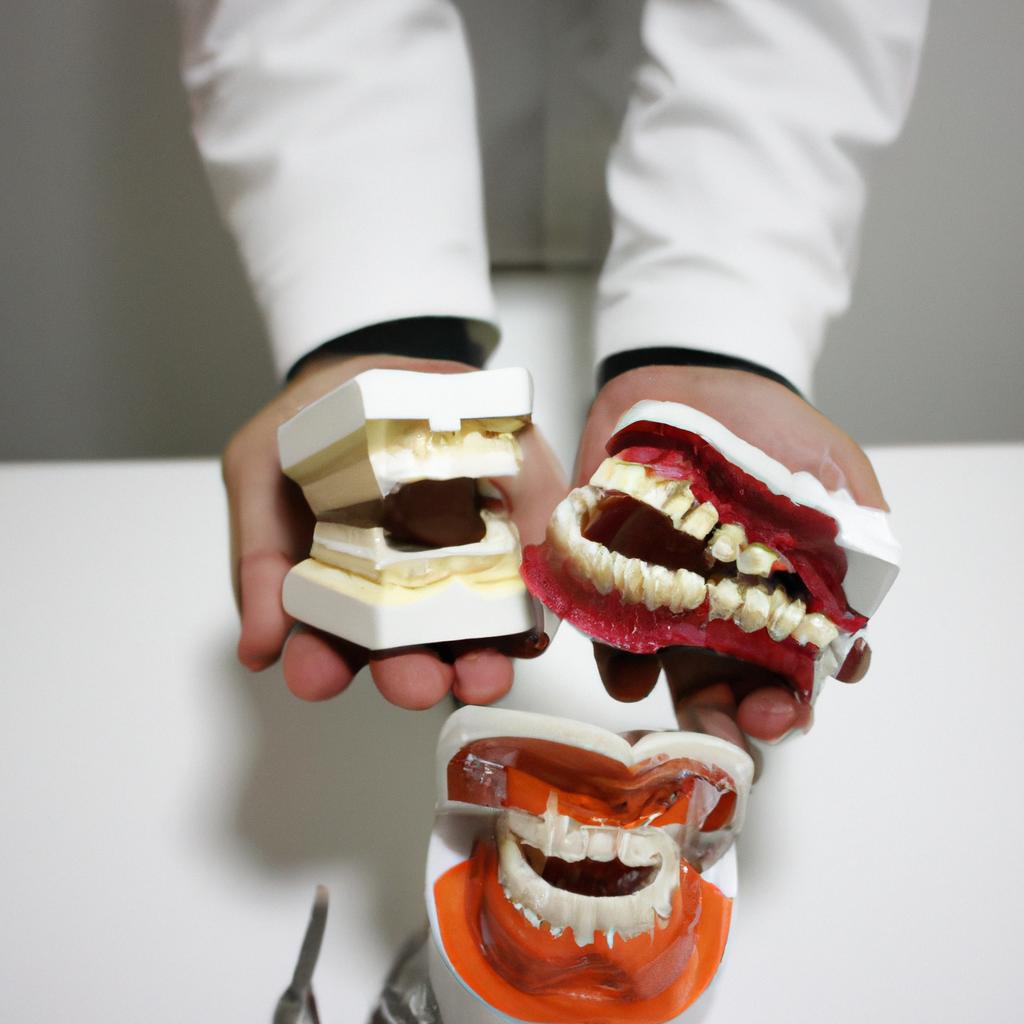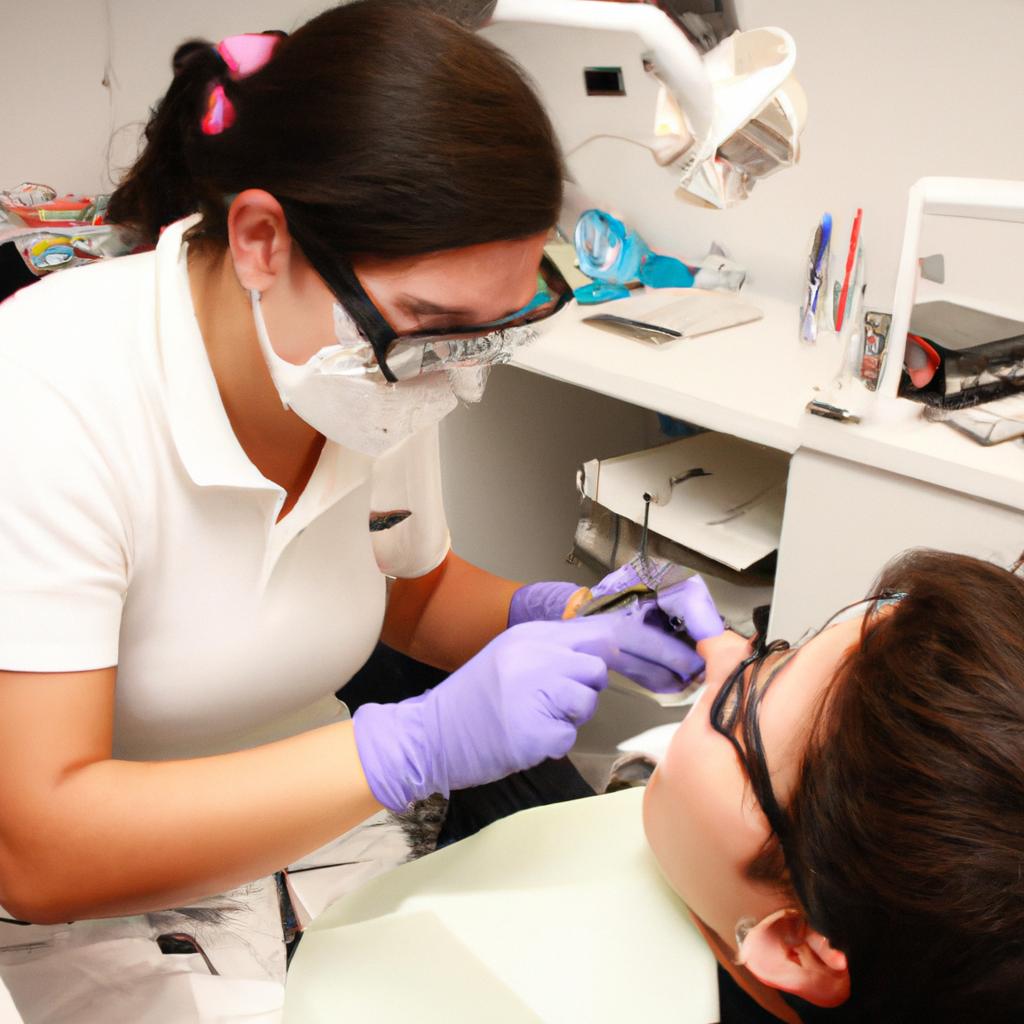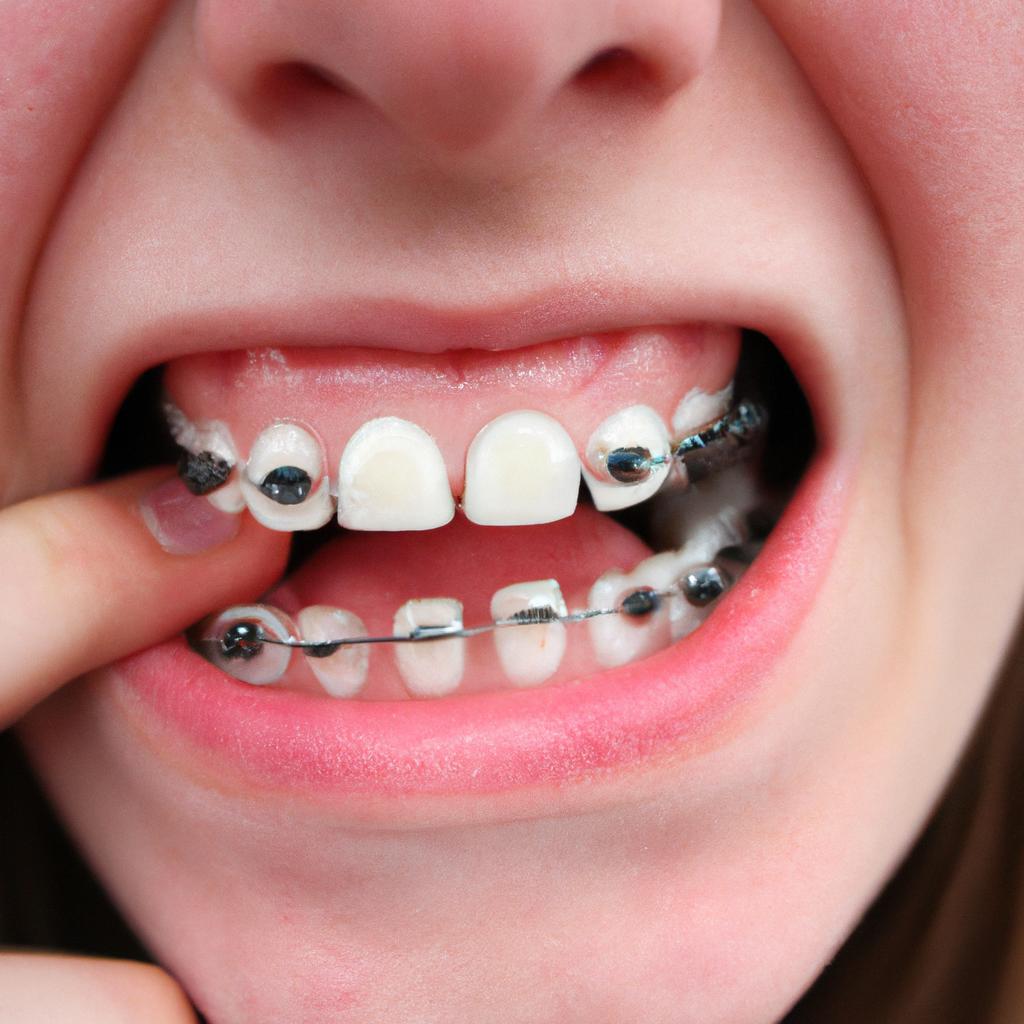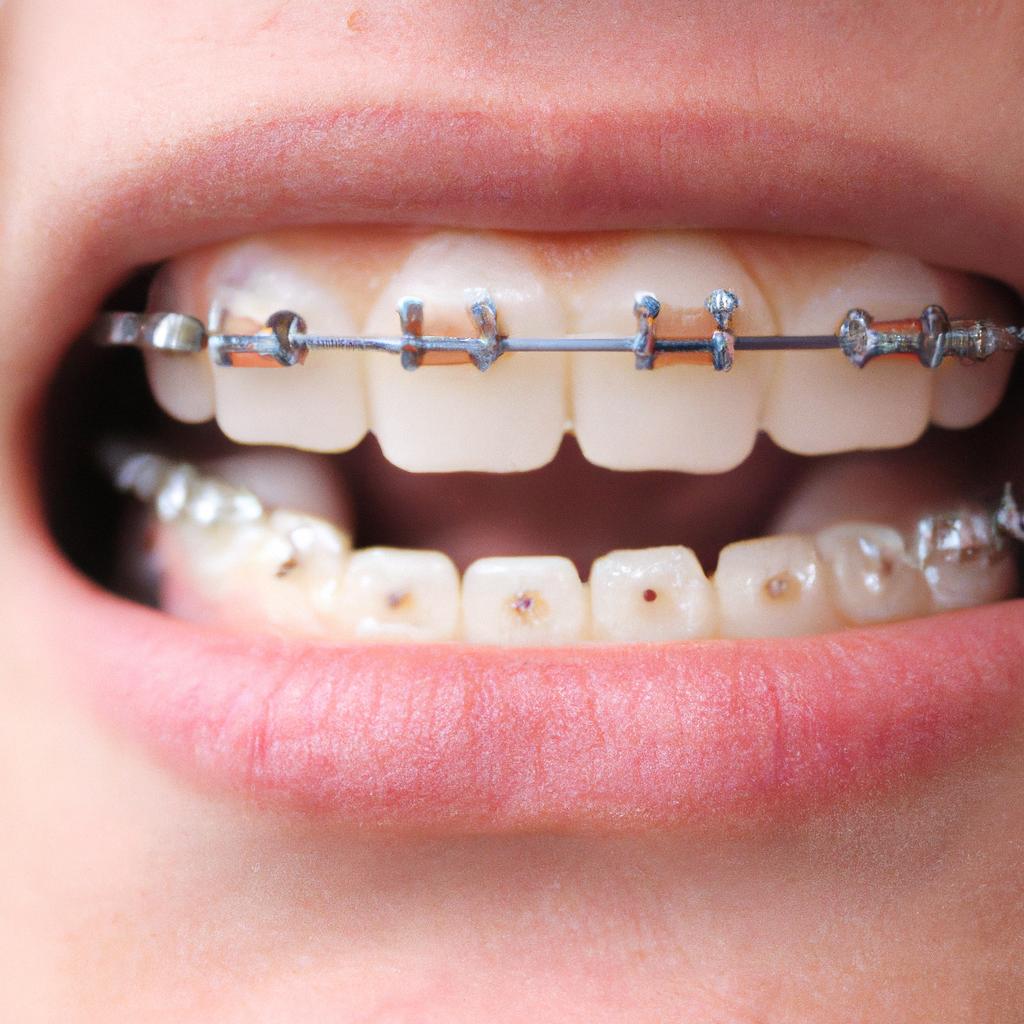Clear Aligners in Orthodontics: A Comprehensive Guide
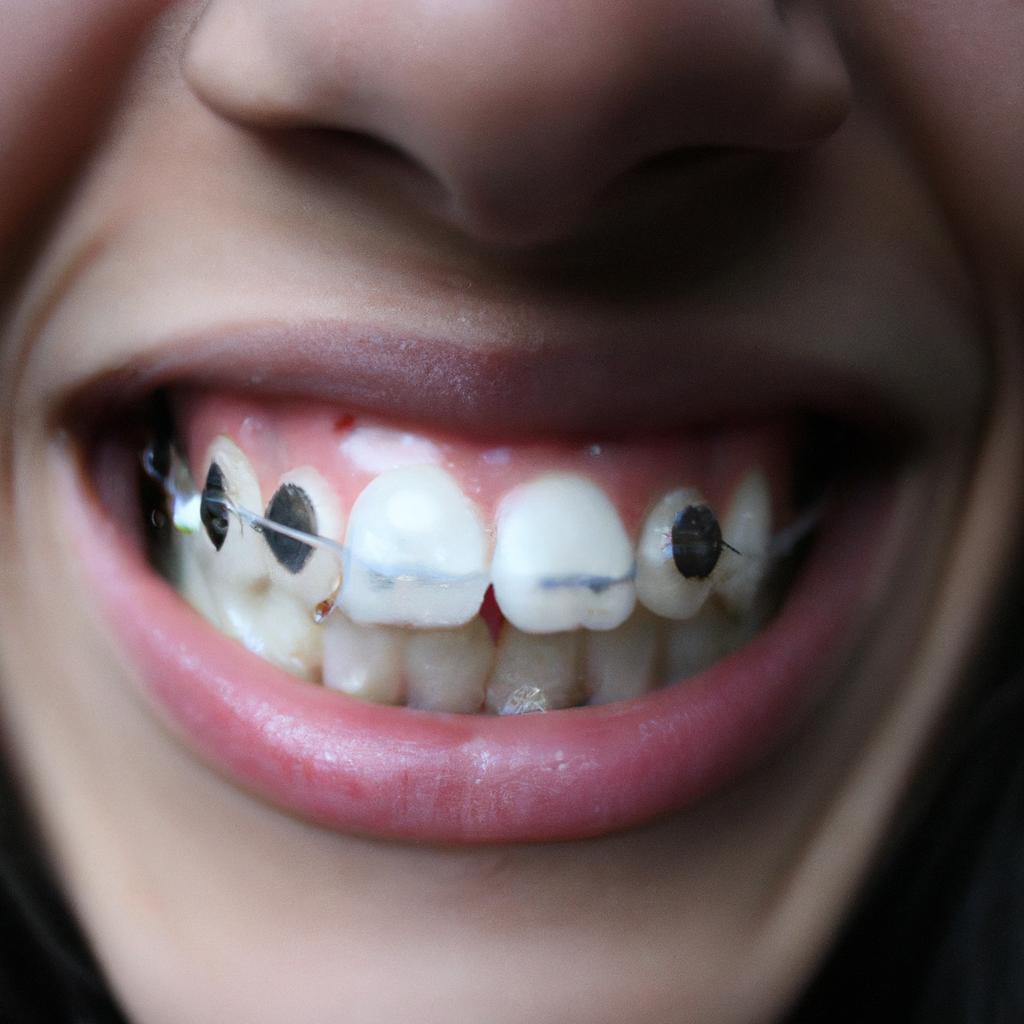
Clear aligners have emerged as a popular alternative to traditional braces in orthodontic treatment. These transparent and removable devices are customized for each patient, providing a discreet option for correcting dental misalignments. For instance, imagine a young professional named Sarah who is concerned about the appearance of her crooked teeth but feels hesitant to commit to wearing metal braces. Clear aligners offer an appealing solution for individuals like Sarah, allowing them to achieve their desired smile without compromising their self-confidence.
Orthodontics has long been associated with the use of fixed appliances such as braces to correct malocclusions and dental irregularities. However, clear aligners have revolutionized orthodontic treatment by offering patients an aesthetically pleasing and convenient approach. By utilizing advanced computer technology and three-dimensional modeling, these aligners apply gentle forces on specific teeth to gradually move them into proper alignment over time. This method allows for greater comfort compared to traditional braces since there are no wires or brackets that can cause irritation or discomfort inside the mouth.
In this comprehensive guide, we will delve into the various aspects of clear aligner therapy in orthodontics. We will explore topics such as the manufacturing process of these custom-made devices, their advantages and limitations compared to other treatment options, and the effectiveness of clear aligners in addressing different types of dental misalignments. Additionally, we will discuss the importance of proper oral hygiene and maintenance during aligner treatment, as well as potential side effects or complications that patients may experience.
One key aspect to consider when discussing clear aligners is the manufacturing process. These devices are created using advanced technology that combines digital scans or impressions of a patient’s teeth with computer software to create a virtual treatment plan. This plan shows how the teeth will gradually move into their desired positions over time. Based on this virtual plan, a series of custom-made aligners are then manufactured using specialized machinery.
Clear aligners offer several advantages compared to traditional braces. Firstly, their transparent appearance makes them virtually invisible when worn, allowing patients like Sarah to undergo orthodontic treatment without drawing attention to their teeth. This can be particularly appealing for individuals who are self-conscious about their smile or those who work in professional settings where aesthetics are important.
Another advantage is the removability of clear aligners. Unlike fixed appliances such as braces, which are permanently attached to the teeth throughout treatment, aligners can be easily taken out for eating, drinking, and oral hygiene routines. This provides greater flexibility and convenience for patients, as they do not have dietary restrictions or face challenges with maintaining proper oral hygiene.
However, it is important to note that clear aligners may not be suitable for everyone or every type of malocclusion. While they can effectively address mild to moderate cases of dental misalignment, more complex cases may require alternative forms of orthodontic treatment. It is crucial for individuals considering clear aligner therapy to consult with an experienced orthodontist who can assess their specific needs and determine if this treatment option is appropriate.
During clear aligner treatment, it is essential for patients to maintain good oral hygiene practices by regularly brushing and flossing their teeth. Aligners should also be cleaned daily using specialized cleaning solutions or gentle toothpaste to prevent bacteria buildup and maintain their transparency. Failure to properly care for aligners can result in discoloration, odors, or increased risk of dental issues such as cavities or gum disease.
Additionally, it is important for patients to adhere to the prescribed treatment plan and wear the aligners for the recommended amount of time each day. Consistency is key in achieving optimal results within the estimated treatment timeline. Failure to wear aligners as directed may prolong treatment duration or compromise the effectiveness of the therapy.
While clear aligners are generally considered safe and well-tolerated, some individuals may experience temporary discomfort or soreness when transitioning to a new set of aligners. This is normal and typically subsides within a few days as the teeth adjust to their new positions. In rare cases, patients may develop allergic reactions or other complications, which should be promptly addressed by an orthodontist.
In conclusion, clear aligners offer a discreet and convenient alternative to traditional braces in orthodontic treatment. They provide patients with an aesthetically pleasing option for correcting dental misalignments while maintaining their self-confidence. However, it is important for individuals considering this treatment option to consult with an experienced orthodontist who can assess their specific needs and determine if clear aligner therapy is appropriate for them. With proper care and adherence to the prescribed treatment plan, clear aligners can help achieve a desired smile transformation and improve overall oral health.
Understanding Clear Aligners
Clear aligners have revolutionized the field of orthodontics by offering an aesthetically pleasing and convenient alternative to traditional braces. These custom-made, virtually invisible trays are designed to gradually shift teeth into their desired positions. To grasp the full potential of clear aligners, it is crucial to comprehend how they work, what conditions they can treat, and the advantages they offer.
To illustrate the effectiveness of clear aligners, let us consider a hypothetical case study: Sarah, a 25-year-old professional with mild crowding in her upper front teeth. Traditional braces would be one treatment option; however, due to her concerns about appearance and comfort during social interactions and professional meetings, she opts for clear aligners instead. Over the course of several months, Sarah diligently wears these removable trays for approximately 22 hours each day as instructed by her orthodontist. Gradually but consistently, her teeth start shifting towards proper alignment until reaching an optimal position that enhances both function and aesthetics.
When contemplating clear aligner treatment, patients often experience a mix of emotions ranging from excitement to uncertainty. Below are some key points that may evoke such sentiments:
- Enhanced self-confidence: Clear aligners allow individuals to undergo orthodontic treatment discreetly without drawing unnecessary attention or compromising their self-esteem.
- Improved oral hygiene: Unlike traditional braces, which can hinder thorough cleaning around brackets and wires, clear aligners can be easily removed for regular brushing and flossing.
- Comfortable fit: The smooth edges of clear plastic trays minimize discomfort or irritation commonly associated with metal brackets or wires.
- Convenience: Clear aligners provide flexibility as they can be removed temporarily when eating meals or participating in sports activities.
In addition to these emotional aspects, it is essential to highlight certain clinical considerations through a table format (see below) that further demonstrate the benefits of using clear aligners compared to traditional braces:
| Aspect | Clear Aligners | Traditional Braces |
|---|---|---|
| Aesthetics | ✓ | ✗ |
| Removability | ✓ | ✗ |
| Dietary Restrictions | ✗ | ✓ |
| Treatment Duration | Varies | Fixed time |
In conclusion, understanding clear aligners involves recognizing their ability to offer discreet treatment options and improve oral hygiene. Patients who choose clear aligners can experience enhanced self-confidence, comfortable fit, convenience, and freedom from dietary restrictions. With this knowledge in mind, let us now explore the numerous benefits that clear aligners provide.
[Transition sentence into the subsequent section about “Benefits of Clear Aligners”] As we delve deeper into the advantages of clear aligners over traditional braces, it becomes evident why they have gained popularity among orthodontic patients.
Benefits of Clear Aligners
Section H2: Benefits of Clear Aligners
Understanding clear aligners provides a solid foundation for recognizing their numerous benefits. By exploring the advantages that these orthodontic devices offer, patients can make informed decisions regarding their treatment options.
To illustrate the effectiveness and versatility of clear aligners, let’s consider a hypothetical case study involving Sarah, a 28-year-old woman with mild crowding in her upper and lower teeth. Upon initial examination, it became evident that traditional braces might not be suitable due to aesthetic concerns. However, after thorough evaluation, her orthodontist recommended clear aligners as an alternative solution. Throughout her treatment journey, Sarah experienced various benefits associated with this innovative approach:
-
Enhanced Aesthetics: Unlike conventional braces made of metal brackets and wires, clear aligners are virtually invisible when worn. This discreet feature allows individuals like Sarah to undergo orthodontic treatment without drawing unnecessary attention or compromising their appearance.
-
Improved Comfort: Clear aligners are custom-made using advanced technology, ensuring a precise fit for each patient. Made from smooth plastic materials specifically designed for comfort, they eliminate the discomfort often associated with metal braces such as irritation or soreness caused by rubbing wires or brackets against soft tissues.
-
Convenience and Removability: One notable advantage of clear aligners is their removability. Patients can easily remove them before meals to enjoy unrestricted eating habits without any dietary restrictions typically imposed by traditional braces. Additionally, maintaining oral hygiene becomes more manageable since brushing and flossing can be performed without obstructions posed by fixed appliances.
-
Minimal Lifestyle Disruption: With clear aligner therapy, frequent visits to adjust brackets or wires become unnecessary as new sets of trays are provided at specific intervals during the treatment process. Consequently, busy individuals like Sarah experience minimal interruption to their daily routines while still achieving desirable orthodontic outcomes.
- Boosted self-confidence and improved body image
- Greater ease and comfort during treatment
- Enhanced social interactions without feeling self-conscious about braces
- Increased motivation to maintain good oral hygiene
The positive effects experienced by patients like Sarah serve as a testament to the transformative power of clear aligners. To further emphasize their advantages, consider the table below, which compares key features between clear aligners and traditional braces:
| Features | Clear Aligners | Traditional Braces |
|---|---|---|
| Aesthetics | Virtually Invisible | Visible metal brackets |
| Comfort | Smooth plastic material | Metal wires and brackets |
| Removability | Yes | No |
| Dietary Restrictions | None | Restricted |
Evaluation and Diagnosis: Moving Forward with Confidence
As patients become increasingly aware of the remarkable benefits that clear aligners offer, it becomes crucial to understand how orthodontists evaluate and diagnose cases for optimal treatment planning. By delving into this aspect, individuals can gain insights into the meticulous process behind successful orthodontic interventions.
Evaluation and Diagnosis
Section Title: Evaluation and Diagnosis
Having explored the benefits of clear aligners in the previous section, it is now crucial to delve into the process of evaluating and diagnosing patients who are considering this orthodontic treatment. This section aims to provide a comprehensive guide on how professionals assess individuals for their suitability for clear aligner therapy.
Assessing patient eligibility begins with a thorough examination of their dental history and current oral health condition. For instance, let us consider an example where a 25-year-old individual presents with malocclusion characterized by crowding and spacing issues. The first step in evaluation involves obtaining accurate digital impressions or traditional impressions using alginate molds. These impressions serve as the foundation for creating virtual models that aid in diagnosis and treatment planning.
Once the models are obtained, orthodontists utilize advanced software programs to analyze them, enabling precise measurements of tooth positions, interarch relationships, and occlusal discrepancies. Through computer-aided simulations, clinicians can simulate potential outcomes based on various treatment options, including different aligner designs or attachments. This information facilitates effective communication between the clinician and patient regarding treatment possibilities and expected results.
To further assist in assessing patient candidacy for clear aligners, here is a breakdown of key considerations:
- Severity of malocclusion
- Patient compliance level
- Skeletal maturity
- Treatment goals
These factors play significant roles in determining whether clear aligners will be suitable for achieving optimal results. While some complex cases may still require traditional braces or other adjunctive treatments like elastics or mini-screws, advancements in technology have broadened the scope of treatable cases with clear aligners.
Table: Clear Aligner Candidacy Factors
| Factors | Description |
|---|---|
| Severity of Malocclusion | Determines if the case falls within the range that can be effectively treated |
| Patient Compliance Level | Assesses the patient’s willingness to diligently follow aligner wear instructions |
| Skeletal Maturity | Evaluates if facial bones have reached their full growth potential |
| Treatment Goals | Considers the desired outcomes and expectations of both the patient and orthodontist |
In summary, evaluating patients for clear aligner therapy involves a comprehensive assessment of dental history, digital impressions, computer-aided simulations, and consideration of key factors. This process enables clinicians to determine whether clear aligners are suitable for addressing specific malocclusions and achieving optimal treatment outcomes.
With an understanding of how evaluation and diagnosis contribute to determining eligibility for clear aligner treatment, we can now explore the next step: treatment planning with clear aligners.
Treatment Planning with Clear Aligners
Section Title: Evaluation and Diagnosis in Clear Aligner Treatment Planning
Having discussed the importance of evaluation and diagnosis in orthodontic treatment, we now turn our attention to the specific considerations involved in treatment planning with clear aligners. To illustrate these concepts, let us consider a hypothetical case study involving a 25-year-old patient presenting with mild crowding and misalignment of their anterior teeth.
Treatment planning with clear aligners begins by conducting a thorough assessment of the patient’s dental condition. This involves evaluating various factors such as malocclusion severity, tooth angulation, arch shape, and occlusal relationships. In our case study, the patient exhibits moderate crowding in both arches along with some rotation of the upper central incisors. By carefully analyzing these findings, an accurate diagnosis can be made to determine whether clear aligners are suitable for this particular individual.
Once diagnosed as a suitable candidate for clear aligner therapy, several crucial steps must be taken during the treatment planning phase. These steps may include:
- Developing an ideal treatment goal: The orthodontist establishes precise objectives based on the desired outcome for each individual patient.
- Creating a digital treatment plan: Utilizing cutting-edge technology, three-dimensional models are generated to simulate tooth movement throughout different stages of treatment.
- Assessing attachments and interproximal reduction (IPR) needs: Attachments or buttons may need to be placed on certain teeth to aid in achieving optimal tooth movements. Additionally, IPR might be required to create space between crowded teeth.
- Determining wear time and tracking progress: The number of hours per day that patients should wear their aligners is established based on individual cases. Regular check-ups allow monitoring of progress through sequential aligner changes.
To better understand how these aspects come together in practice, please refer to Table 1 below:
Table 1: Key Considerations in Clear Aligner Treatment Planning
| Consideration | Description |
|---|---|
| Treatment objectives | Clearly defined treatment goals tailored to each patient. |
| Digital planning | Utilizing advanced software for precise treatment mapping. |
| Attachments and IPR | Placement of attachments or interproximal reduction needs. |
| Monitoring progress | Regular check-ups to track the patient’s treatment journey. |
In summary, evaluation and diagnosis play a pivotal role in determining the viability of clear aligner therapy for orthodontic patients. Following an accurate assessment, treatment planning encompasses key considerations such as establishing treatment goals, digital planning, attachment placement, and monitoring progress throughout the course of treatment.
Transition into subsequent section:
With the foundations of evaluation, diagnosis, and treatment planning established, it is essential to ensure proper wearing and maintenance of clear aligners to maximize treatment success. Let us now delve into the details surrounding this crucial aspect of clear aligner therapy.
Wearing and Maintaining Clear Aligners
Transitioning smoothly from the previous section on treatment planning, let us now delve into the essential aspects of wearing and maintaining clear aligners. To illustrate their effectiveness, consider a hypothetical case study where a patient named Sarah undergoes orthodontic treatment using clear aligners.
Sarah’s journey began with an initial consultation to determine her suitability for clear aligner therapy. Upon evaluation, it was found that Sarah had mild crowding in her lower front teeth. Her dentist recommended clear aligners as an ideal solution due to their discreet appearance and convenience. After thorough examination and digital impressions were taken, a personalized treatment plan was created using computer-aided design software.
Once Sarah received her custom-made set of clear aligners, she was instructed on how to wear and maintain them properly. Here are some key points to remember:
- Consistency is crucial: It is important to wear your aligners for at least 20-22 hours per day, removing them only when eating or brushing your teeth.
- Cleanliness matters: Regularly clean your aligners by gently brushing them with lukewarm water and non-abrasive toothpaste. Avoid using hot water or harsh chemicals that may damage the material.
- Maintain oral hygiene: Brush and floss your teeth thoroughly before putting the aligners back in place. This helps prevent plaque buildup and ensures optimal results.
- Mindful eating habits: Remove your aligners whenever consuming food or beverages (except plain water) to avoid staining or damaging them.
To further emphasize the significance of proper maintenance during this orthodontic journey, we present a table summarizing the do’s and don’ts of wearing and caring for clear aligners:
| Do’s | Don’ts |
|---|---|
| Wear aligners as advised | Eat or drink with them in |
| Clean them regularly | Use abrasive toothpaste |
| Maintain oral hygiene | Expose them to hot water |
| Store them properly | Chew gum or smoke while wearing |
By adhering to these guidelines, patients like Sarah can ensure the effectiveness of their clear aligner treatment. The next section will focus on the importance of monitoring and follow-up appointments, which play a vital role in achieving desired orthodontic outcomes.
Moving forward, let us now explore the crucial aspect of monitoring progress and scheduling follow-up appointments during clear aligner therapy.
Monitoring and Follow-up
After understanding the importance of wearing and maintaining clear aligners, it is crucial to highlight the significance of continuous monitoring and follow-up throughout the orthodontic treatment. By closely tracking progress and making necessary adjustments, orthodontists ensure optimal outcomes for their patients.
Monitoring progress during clear aligner therapy involves regular check-ups with the orthodontist. For instance, let’s consider a hypothetical case study of a patient named Sarah who recently began her clear aligner treatment. At each follow-up appointment, Sarah’s orthodontist assesses the fit of her aligners, checks for any discrepancies or discomfort, and monitors the movement of her teeth. This process allows timely intervention if needed and enables modifications in treatment plans based on specific requirements.
To effectively monitor patients’ progress during clear aligner therapy, orthodontists rely on various methods such as:
- Clinical examinations to evaluate alignment changes
- Digital imaging techniques (e.g., intraoral scans) for precise measurements
- Radiographic assessments to analyze bone structure alterations
- Patient feedback regarding comfort levels and overall satisfaction
These strategies offer valuable insights into treatment progression, enabling orthodontists to customize future aligner sets accordingly.
In addition to meticulous monitoring, consistent follow-up appointments provide an opportunity for addressing concerns and educating patients about proper oral hygiene practices. During these visits, orthodontists can guide individuals on how to maintain good dental health while undergoing treatment with clear aligners. It is essential that patients adhere to recommended guidelines regarding wear time, cleaning protocols, dietary restrictions, etc., which contribute significantly to successful outcomes.
Emphasizing the commitment required by both parties involved in clear aligner therapy – the orthodontist and the patient – here are some key points worth considering:
- Regular check-ups allow early identification of potential issues.
- Collaboration between the patient and orthodontist ensures effective communication.
- Adherence to prescribed treatment protocols leads to desired outcomes.
- Timely adjustments and modifications enhance treatment efficiency.
To provide a concise overview of the monitoring and follow-up process, the following table outlines key aspects:
| Aspect | Importance | Benefits |
|---|---|---|
| Regular Check-ups | Early identification of issues | Prevents complications |
| Patient Education | Promotes adherence to guidelines | Ensures optimal results |
| Communication | Facilitates effective collaboration | Enhances patient satisfaction |
In summary, continuous monitoring and regular follow-up appointments play an integral role in clear aligner therapy. By tracking progress, addressing concerns promptly, and educating patients about proper maintenance, orthodontists can achieve successful outcomes for their patients.

